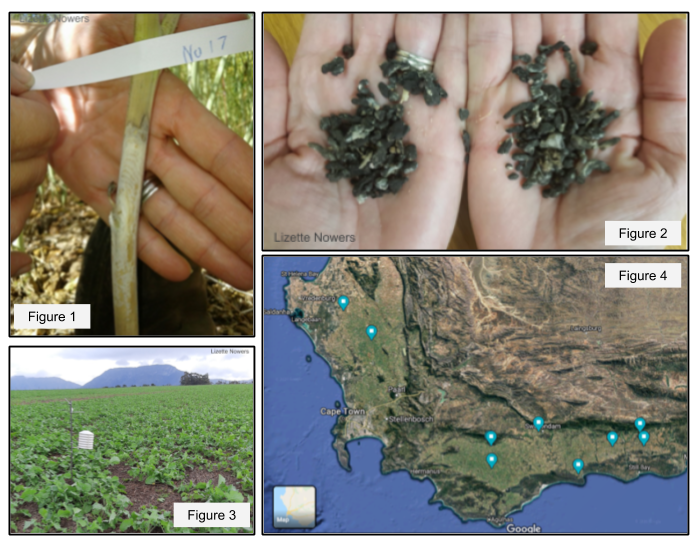
Author: Ms. Lizette Nowers
Western Cape Department of Agriculture, Directorate Plant Sciences, Plant Pathology.
Reviewed: Lisa Rothmann, South African Sclerotinia Research Network
Since canola was established in the Western Cape at the end of the last century, the crop has proven itself as an integral part of dry land food production of scale. The picturesque images of rolling yellow hills have become a familiar face of the south western corner of our beautiful country. According to statistics from a 2018 survey, canola is the 4th most widely planted crop (reported in hectares) in the province.
However, unfortunately, the visitor to this website and this article in particular, might be ominously acquainted with the flourishing danger that lurks beneath and amidst this jolly yellow carpet… Sclerotinia Stem Rot (SSR) of canola is a sporadic fungal disease caused by Sclerotinia sclerotiorum. It has the potential to cause substantial yield losses for canola producers in South Africa.
Symptoms of SSR emerges during the flowering season. The start of the fungal infection can be identified with a tiny watermark anywhere on any of the stems. This watermark becomes a fluffy white lesion which can expand to a large lesion, seen in Fig. 1. The infection culminates in dark, hard survival structures called sclerotia (as seen in Fig. 2) that is lodged inside and/or on the stem. These sclerotia are the key to the longevity of the fungus and enables it to cause disease in following seasons when disease conducive factors are favourable. Sclerotia are equipped to survive for multiple years in the soil and the fungus is entertained by an extremely wide host range of broad leaf plants. If we were to simulate canola production with the reality television show “Survivor”, SSR would make for a worthy “Survivor competitor”!
The disease is sporadic in the sense of geographical distribution, with one field being healthy and another field in the same area being highly infected. It is also sporadic over a temporal scale, where it can be hugely present in one year and totally absent on the same farm in the following year. The reason for this phenomenon is that this enigmatic disease is driven by an array of factors and interactions. It is therefore imperative to keep close tabs on these factors to enable effective and economic SSR management.
Since 2013, the Western Cape Department of Agriculture has endeavoured to shed some light on the status quo of SSR in the province. Every year accurate on-site and field specific assessments of SSR incidence were made in the Department’s canola trials at fixed locations on its two research farms namely Tygerhoek (Riviersonderend) and Langgewens (Moorreesburg), as well as at long term trials on a commercial farm, Uitkyk (Riversdale). These assessments are conducted by counting diseased plants and estimating disease severity.
Apart from monitoring the incidence of the disease, the Department has also expanded this research into a project to both monitor the effect of some of the disease-causing parameters, as well as experimenting with a few management strategies.
Some of the factors that are being monitored, include the following:
- crop history – how often were host crops encountered in a rotation system
- plant density – denser plant canopies may lead to higher humidity, and a more conducive micro-climate
- tillage – how are sclerotia buried or exposed between seasons
- fungicide spraying – at different physiological stages for timely applications
- micro climate under the canola canopy – humidity and temperature plays a very important role in development of SSR,
- macro climate – wet soils are needed for disease initiation from sclerotia germination and
- even though no genetic resistance are currently available, cultivars are also being monitored.
Data for potential associations between SSR incidence in correlation with these factors were initiated in the 2019 season and a usable set of data should be available by the end of 2024. As SSR occurs sporadically, it is desirable to expand the distribution of incidence monitoring beyond the Department’s three fixed locations, across the province to more canola producing areas. For the 2020 season a number of commercial farmers have agreed to participate in this survey. The map in Fig. 4 indicates the locations for the current season’s monitoring actions.
To challenge this disease, we should gain as much data as possible to outwit, implement effective production strategies to outplay and then, hopefully, outlast this formidable fungal disease! All producers that are interested in partaking in this monitoring effort are welcome to contact the Department for possible collaboration and join the “tribe” to “outwit, outplay and outlast” this challenge!
For more information please feel free to contact, Ms Lizette Nowers, (Plant Pathology), Directorate Plant Sciences, Western Cape Department of Agriculture.